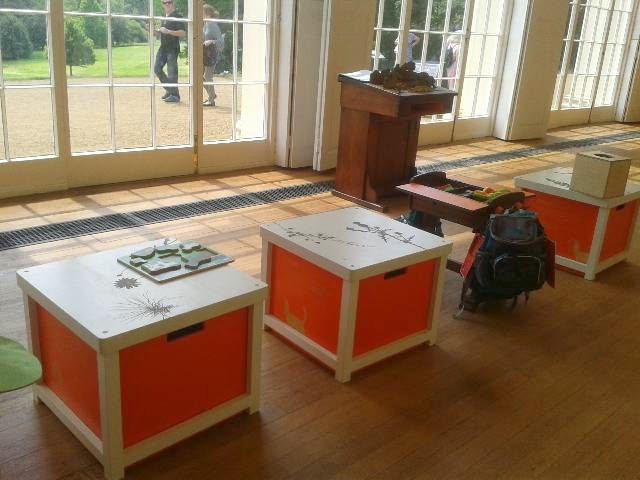Lloyd Park, Forest Rd
Walthamstow E17 4PP
London
Thursday July 25th
2014
For anyone not immediately local the easiest approach to
this, one of three William Morris-linked sites on our list, is via the Victoria
Line which leaves you in busy Walthamstow Central; I was more than happy to
revisit one of London’s better bus stations but we decided to walk following
the directions usefully painted high on the brickwork. The side roads we
followed obviously took a pride in being on a designated route and there were
ample displays of window boxes and pots, most people’s front gardens now taken
up with the borough’s bins – a common problem this.
Our plan had been to picnic in Lloyd Park
named for the last owners of the Water House, a wealthy printer who left the
estate to the borough in 1900. It seemed an ideal area with something for
everyone – tennis courts, some wild areas, children’s play equipment and formal
and less formal flower beds. The gallery’s tea-room opens onto the gardens so
doubles as a park café. However like everyone else we were caught out by a
sudden downpour and, having abandoned that very British habit of never going
anywhere without a brolly (sunshine goes to the head), instead of a good
explore of the park we had to shelter under a tree generous enough to allow us
to eat our rolls in comparative dryness even if standing up.
We made a dash for the front of the house, which is where
William’s parents moved (from somewhere quite local) when he was 14. It’s a
handsome house, on the solid side, and its own history is not forgotten as you
tour through the rooms. The terrazzo floored entrance hall is now the shop with
the main exhibition room off to left and right in the bays or wings. The gallery was re-vamped just two years ago
and the exhibits are well presented: a balanced combination of artefacts,
interactive games (brass rubbing/make your own stained glass window),
information and context. The rooms are
both chronological and thematic so we have ROOM 1 – Morris the Man which allows his own quotes
to mingle with those of his peers and admirers, and explains how his love of local nature round the ‘suburban
village ‘ of Walthamstow and Epping influenced some of his later designs.
Largely educated at home – he ‘left’ Marlborough College after some
anti-teacher demonstration and university life at Oxford was more about making
formative friends and contacts rather than the degree itself (does that sound
familiar?). At Exeter College he met another like-minded artistic spirit – Edward Burne-Jones – and the rest as
they say is history.
To be fair to William Morris he never forgot how privileged
he was to be able to follow his inclinations, to have inherited wealth from his
canny investor father, and how capital was never in the hands of the
workers. He was even aware that many of
his hand produced goods – the wallpapers and textiles – were beyond the reach
of many people and ironically chafed against some of his more expensive and
expansive clients. Surprisingly for such
a life-long idealist he was quite a canny entrepreneur and managed to secure
several jobs at churches undergoing restoration, using his friends and wife as
both agents and in Jane Burden, now Morris’s wife, an adept embroiderer.
Later on the firm exhibited at trade events and eventually
opened a prestigious showroom in Oxford Street, charmingly evoked in a separate
gallery room. The museum follows this
expansion of his business with opportunities to understand block printing/tile
making/weaving on a loom with a section on his work at Merton Abbey (we shall
doubtless be going there in due course) and indeed the Red House – the first
marital home in Bexley are included also. Getting your friends to help decorate
is always a good ploy, especially if they are all artists, but unfortunately it
also meant breaking up the marriage as Rossetti seduced Jane away from William.
The upstairs rooms of the Gallery were today unbearably hot
and stuffy so we gave them less attention – they look at Morris’ legacy inspiring
others such as Voysey, Webb, Crane and the wonderfully named Mackmurdo in the
Arts & Crafts Movement. Morris was always ‘hands-on’ be it as an artist
designing for the company or as a socialist out campaigning (100 lectures a
year) or demonstrating – banners abound. He founded the Kelmscott Press also and
there are examples of beautifully produced but rather turgid works.
To tie in with the anniversary of the start of World War I
the special exhibition room is devoted to the posters and art work of Frank
Brangwyn who spent his early years in Belgium and campaigned on behalf of the
refugees the war brought from that country to this one.
The café has been built onto the side complete with glass
roof vents etched with a Morris design, and the Unisex toilets have large scale
colour reproductions of the ever popular wallpaper designs : there can be
no-one who has not seen a sample of his work somewhere, and the
gallery as a whole makes an excellent job of celebrating his life and work.
PS We had planned to photograph the tiling down on
Walthamstow Victoria Line platform to prove the above point but the tube was
having none of it today as the line was suspended from Seven Sisters so we made
our way home via Liverpool Street.


















































